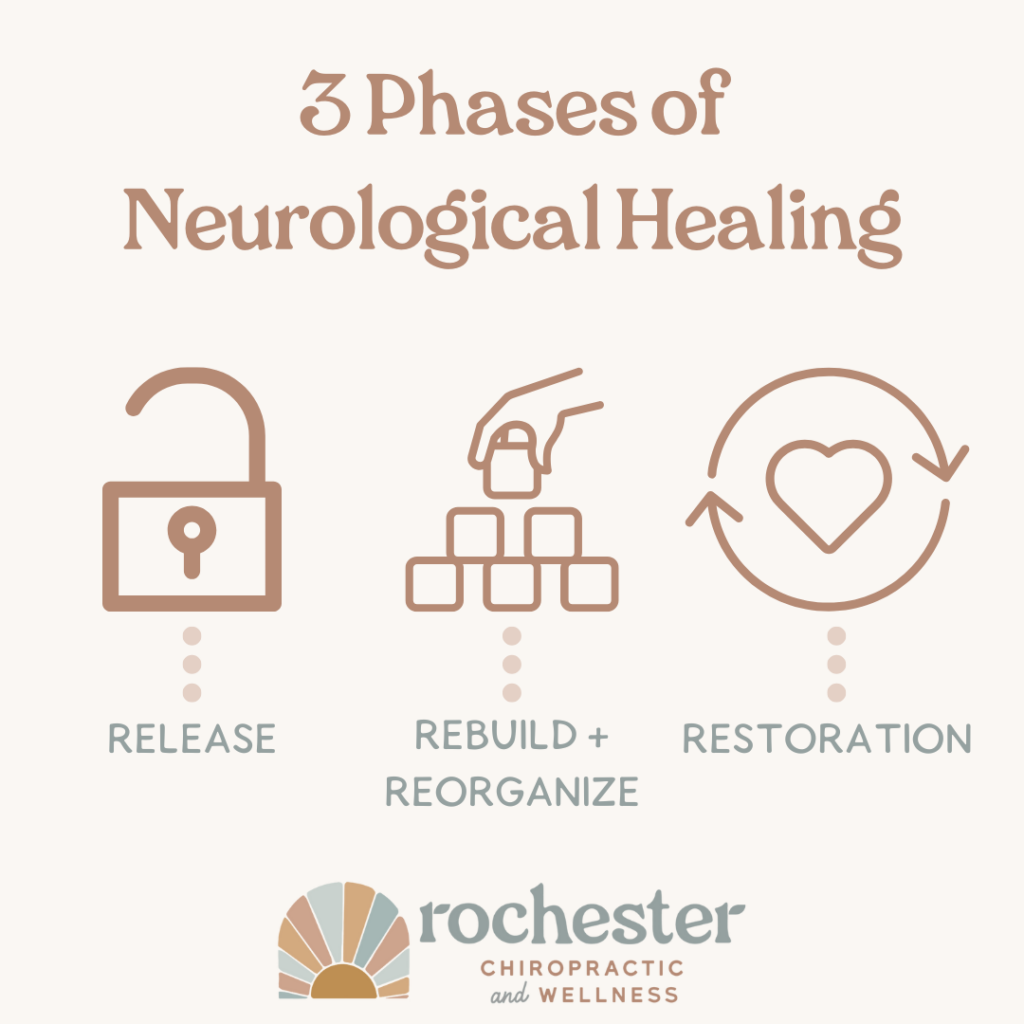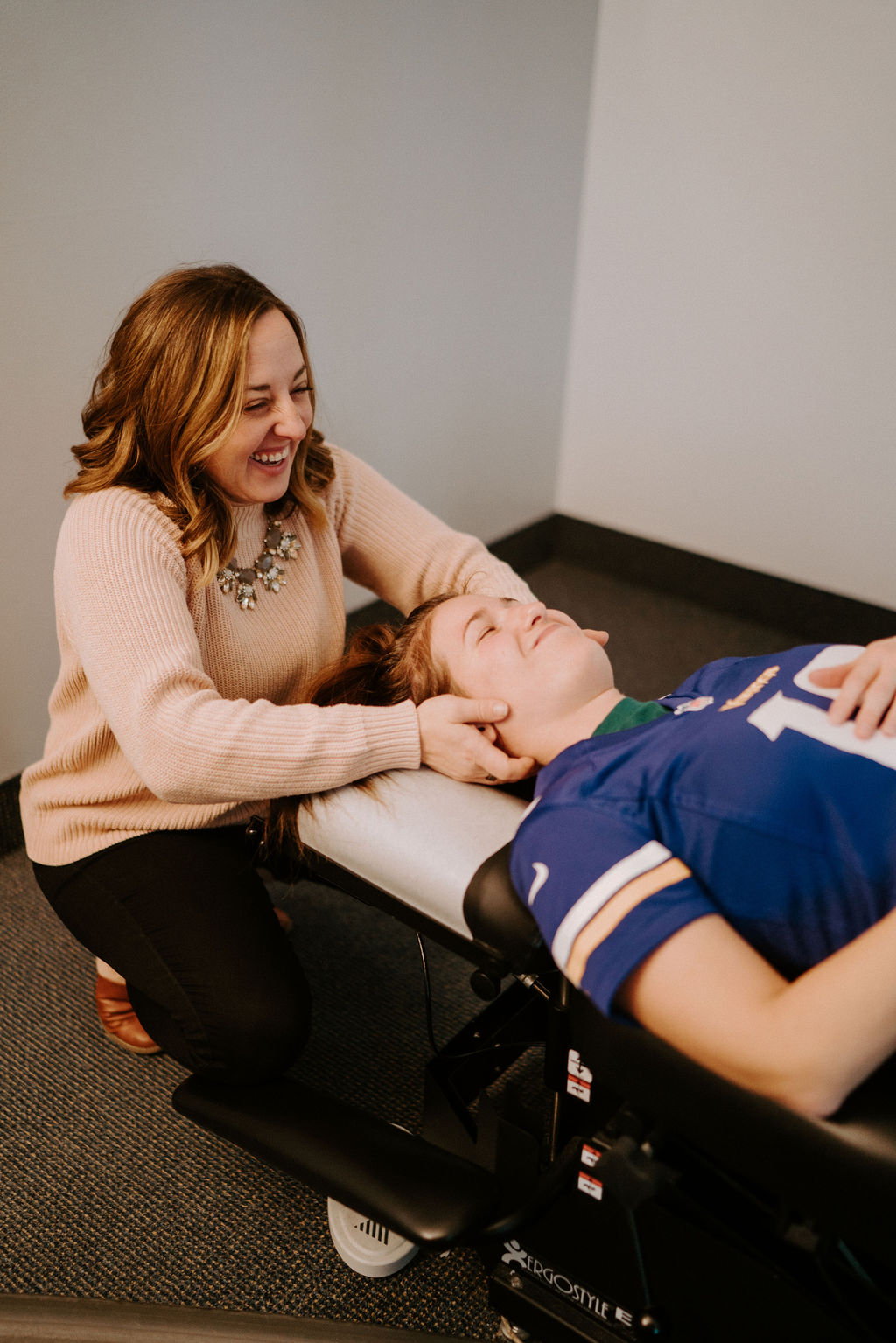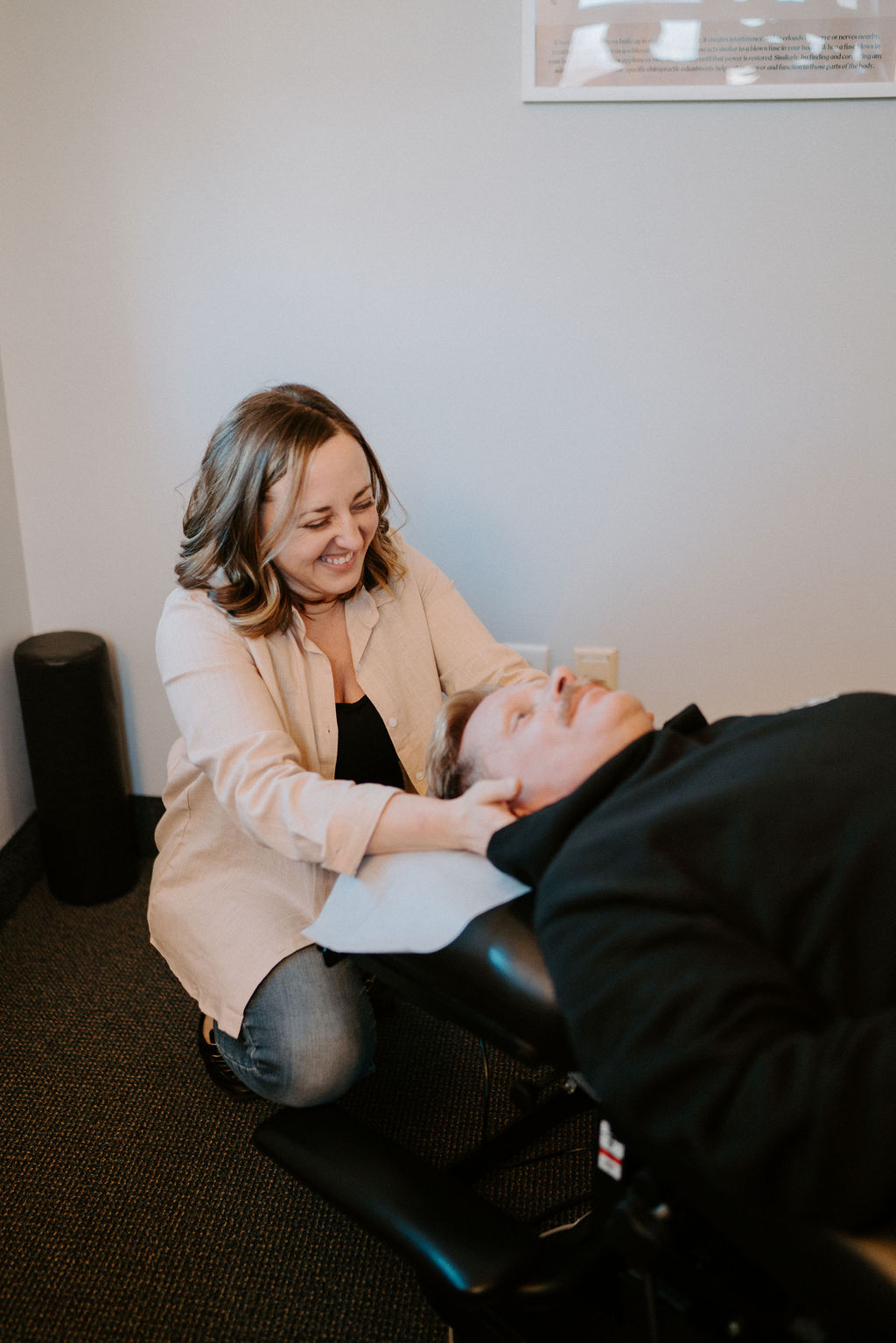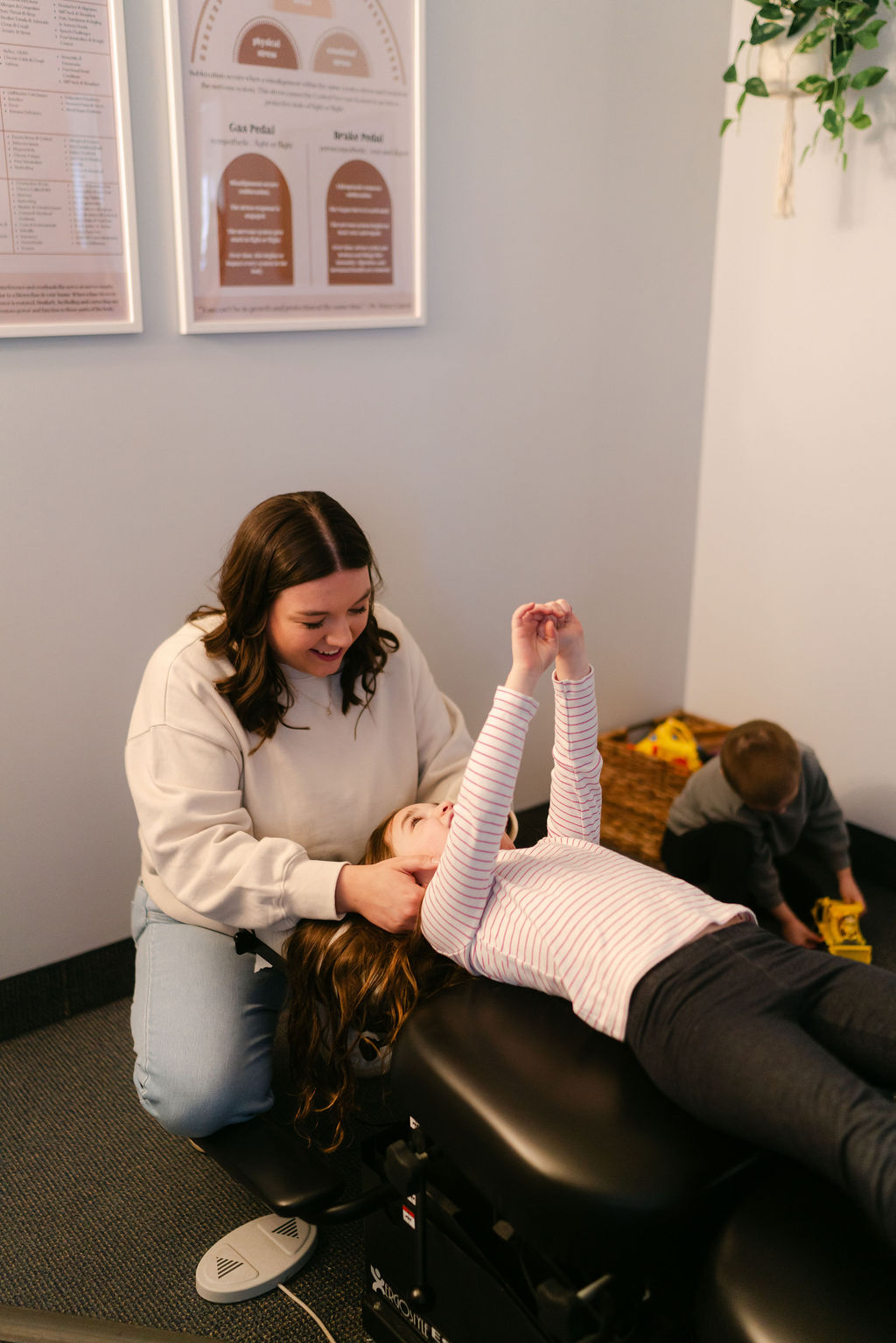WElcome TO
Explore our blog that focuses on holistic care for any and all ages - pediatric well-being, pre/post-natal health, and adult vitality.
THE BLOG

Neurological healing is no easy task. Nor is it normally a linear, straightforward path. In fact, it’s most commonly quite the opposite, going through multiple stages and phases on its way to optimal healing and outcomes.
The first challenge parents and patients face when trying to determine whether or not things are moving in the right direction with neurological healing is that the process is the stark contrast opposite of traditional medical treatment. Every single component of the medical system is designed not with healing in mind, but with suppressing, stopping, and shutting things down as the ultimate goal.
Have an infection? Kill it off with an antibiotic (which literally means anti-life).
Have a fever? Shut it off with a fever suppressor.
Have inflammation? Shut it down with steroid-based medications.
Have hyperactivity and impulsivity? Suppress it with stimulant medications.
Have anxiety? Cover it up and suppress it with drugs.
The medical way is one that is supposed to “work” fast and, therefore, be readily apparent. Unfortunately, parents today especially know that what we discussed is very true – the vast majority of the time, drugs and medications are doing nothing to address the actual root cause, create any actual healing, and they also come with a whole host of unwanted side effects.
So, what other options do we have? Well, if you’re reading this, then it’s likely that you’ve already begun to take the root cause of yours or your child’s challenges head on with neurologically-focused chiropractic care, or you’re strongly considering it and wondering exactly how that process works.
To make this super simple to understand, we’ll be breaking things down into three parts. First, the healing phases we’ll discuss are:
- Release Phase
- Rebuild + Reorganize Phase
- Restoration Phase

Phase 1 – Release
The first phase of neurological healing + restoration is often the bumpiest. The longer you have been subluxated and stuck in sympathetic dominance (dysautonomia), the deeper those stress patterns and dysfunctions set in. The body is doing all it can to adapt, but in the toughest of cases (Perfect Storm + Neuro Intensive ones especially), we generally find that the nervous system is just flat out worn out and exhausted.
Therefore, when you release those deep subluxation patterns in the first two (2) weeks to two (2) months of care, oftentimes, patients will experience some form of “neuro detox” where certain signs and symptoms may get a bit worse.
This is really no different than what happens when you get a fever, diarrhea, or traditional immune response – the body is actually getting “sick” to get well again.
So, in the vast majority of these neurological detoxes that occur way early in care, it’s actually a “good” sign that healing is happening. We’re getting the nervous system unstuck from the long-standing stuck, stressed, and exhausted subluxation patterns it’s been in.
Phase 2 – Rebuild + Reorganize
This is an exciting phase of care, and it’s really rooted in the science of something called neuroplasticity. Which honestly is what all of neurologically-focused chiropractic care is based upon.
Neuroplasticity, also known as neural plasticity or brain plasticity, is the ability of neural networks in the brain to change through growth and reorganization. It is when the brain is rewired to function in some way that differs from how it previously functioned.
Subluxation, dysautonomia, and the “Perfect Storm” are all what stop neuroplasticity, growth, and optimal development dead in its tracks and throw things off course. Therefore, when we hit this stage of care, and we start to see growth and reorganization happening again and a child getting back on track with their milestones and development – oh man, is it exciting!
What does rebuilding + reorganization look like practically? Check out the following list to spot the signs of this stage in progress:
- INSiGHT Scans shifting, changing, calming, clearing, and reorganizing
- Oftentimes this can be tracked with our “neurometrics” and scores
- Improved Neuro-Postural Patterns
- No more head tilt + rotation, shoulders relaxed and level, etc.
- Improved Neuromuscular Tone + Coordination
- Observed through movement, gait analysis, etc.
- Improved Neurological “Soft Signs”
- Sleeping better, eating better, improved digestion, better immune health, improvements in posture and coordination, etc.
- Improved Focus + Endurance in School, Therapy, etc.
- Being able to do more during therapy appointments and school
- Less Severe Subluxation Patterns and Adjusting Restrictions
- When things shift, move, and get easier to adjust
By no means does a child or patient need to experience everything on that list to be in this phase of neurological healing, as healing is unique to each individual. However, even observing and having just a couple of them means things are progressing and on the right track to optimal healing and neurological restoration!
Phase 3 – Restoration
This phase of care is the ultimate goal of our initial care plans, but honestly, it’s just the beginning of the best part – the child or patient is now experiencing a high quality of LIFE once again!
We feel strongly that we are designed to be strong, healthy, resilient, and happy, and therefore live a high quality of life as a result! This stage of care is when kids and patients really have had transformative changes with their health and day-to-day experience a quality of life far greater than what they had prior to starting chiropractic care.
This stage then sets the stage for wellness, but the work is not all the way done. In this stage, we want to stay on the job of neurological healing and continue to deploy neuroplastic healing principles in order to put “slack” and “stability” in the system.
This third state of neurological healing is essential for one reason – life goes on. Meaning kids are still going to have growth spurts, falls and injuries, colds and sickness to get through, social and emotional challenges, school, sports, seasonal changes, and so much more they still need to stay ahead of and adapt to. Adults are right there with them with work stressors, seasonal allergies, social engagements, and other physical stressors.
By completing this final stage of the neurological restoration care plan, we can then transition into lifetime wellness care with a strong, resilient, and more stable nervous system. A more stable nervous system can better withstand various regular life stressors and stay healthy and strong through them!
That is the ultimate goal we have for our patients – to not just get healthy for a season, but stay there for good! To do that, this third phase and achieving restoration is essential.
Diving Deeper into Neurological “Soft Signs” of Healing
While every single one of us, from the parent team to the provider team, wants to see massive changes and achievement of the big goals happen right away… science and clinical experience let us know that, typically, that is not the case.
So often, and so rightfully so, some of the most common examples parents have for BIG goals for their children’s care include things like starting to walk or talk, eliminating seizures or autism spectrum related challenges, improving focus and behavior, lessening anxiety and depression, and so forth. For the purpose of this article, we’ll refer to these functions as “brain-based” or “higher level” functions.
In contrast, more primary and basic neurophysiological functions that are essential to health are things like eating, sleeping, digestion (pooping), motor planning, respiratory + immune health, and so forth. These core health functions could also be called more primal or foundational components of health, and what many parents and providers don’t know is it’s these things that get offline and off track first, which then leads to the bigger “brain based” problems down the road as neurological function and development is compromised.
Therefore, on the road to optimal neurological healing, we often need to see changes with these “soft signs” (and scans), and the more basic physiological functions first.
- When a teen intensive patient struggling with anxiety, epilepsy, and exhaustion starts to finally fall asleep easier and stay asleep longer, we know we’re on the right track!
- When a three (3) year old patient recently diagnosed with autism and apraxia (nonverbal) begins experiencing better digestion, immune health, and gross motor planning, we know we’re on the road to recovery + restoration!
- When a grade schooler struggling with ADHD and behavioral regulation challenges has more relaxed shoulders, less tension, and gets adjusted easier, we know we’re making the right changes happen to their nervous system!
So often for parents, not seeing the big changes happen instantly with chiropractic care can be frustrating and, if we’re being honest, even disheartening. But when we can point out these incredibly important changes on their INSiGHT Scans and with their neurological “soft signs,” we can rebuild that hope and let you know we’re heading in the right direction!
If you have any questions at all about what phase of care your child is in (or yourself), do not hesitate to ask and really dig in with your doctor at the next visit. We love talking through this stuff with our patients, and always do our best to stay ahead of it, making sure you know what to look for and what to track as care progresses through each and every phase of care!

As a parent, watching your once full-of-life teenager transform into someone withdrawn, constantly overwhelmed, and struggling with anxiety or depression can be heart-wrenching. You’ve likely consulted various healthcare providers, tried different approaches, and perhaps even considered medication—yet your teen’s struggles continue.
What if we told you that the root cause might not be the “chemical imbalance” that most conventional doctors continue to blame these rapidly increasing teen challenges on?
The Crisis Our Teens Are Facing
The United States is facing an unprecedented mental health crisis among adolescents. According to recent CDC data, 44% of American high school students report persistent feelings of sadness or hopelessness. Even more alarming, nearly one in three teenage girls report having seriously contemplated suicide—twice the rate of boys.
What’s particularly interesting is that during this same period of rising mental health challenges, we’ve seen some positive trends for young people. Including reduced alcohol consumption and fewer teen pregnancies. Yet anxiety and depression have continued to surge across all demographics.
Beyond the Chemical Imbalance Theory
While traditional medicine typically addresses these challenges with medications aimed at correcting presumed chemical imbalances, many parents find these approaches merely mask the symptoms rather than address underlying causes.
The truth is, the ‘chemical imbalance’ theory behind anxiety and depression isn’t as scientific or proven as most people believe.
What’s really happening? Our teens’ nervous systems are stuck in ‘fight or flight’ — constantly dysregulated, exhausted, and overwhelmed. They’re trapped in stress mode 24/7, often chasing constant stimulation just to cope.
Understanding the Neurological Foundation
From a neurological perspective, anxiety and depression are often connected to imbalances in the autonomic nervous system. Specifically between the sympathetic “fight or flight” response and the parasympathetic “rest and digest” functions.
This neurological imbalance, called dysautonomia, represents a crucial but often overlooked root cause that can leave teens stuck in a persistent state of stress and emotional dysregulation.
The Critical Role of the Vagus Nerve
The vagus nerve is the primary component of the parasympathetic nervous system and plays a crucial role in emotional regulation, stress recovery, and social connection.
This “wandering nerve” connects the brain to vital organs and helps regulate heart rate, breathing, digestion, inflammation, and emotional states.
Research shows that lower vagal tone is significantly linked to challenges in managing emotions and a heightened sensitivity to stress. Exactly what we see in teens with anxiety and depression.
When vagus nerve function is compromised due to subluxation and nervous system stress, it affects your teen’s ability to calm themselves, process emotions, and maintain balanced mood states.
The “Perfect Storm” Leading to Teen Mental Health Issues
This neurological dysfunction often begins early in life, what we call “The Perfect Storm”:
- Maternal stress during pregnancy can affect the developing fetal nervous system through stress hormones that cross the placental barrier.
- Birth interventions like forceps deliveries or C-sections can cause subtle injuries to the upper neck and brainstem regions. Potentially affecting the vagus nerve and leading to subluxation.
- Early childhood factors continue building the foundation for later challenges, including repeated infections, frequent antibiotic use, disrupting the gut-brain axis, environmental toxins, and physical injuries.
- Modern lifestyle factors significantly amplify these neurological imbalances. Including digital technology, sleep disruption, decreased physical activity, and poor nutrition affecting the gut microbiome and vagal function.
Many researchers have noted that the sharp rise in teen mental health issues coincided with the widespread adoption of smartphones around 2012, pointing to digital technology as a significant factor—but the full picture is much more complex and begins much earlier in life.
Recognizing Signs of Nervous System Dysfunction in Your Teen
If your teen is struggling, look for these signs that may indicate neurological imbalance:
- Physical signs like sleep disturbances, appetite changes, digestive issues, continually getting sick, fatigue + exhaustion, and restlessness often reflect an underlying neurological imbalance.
- Emotional indicators such as persistent sadness, excessive worry, irritability, and loss of interest stem from an autonomic nervous system stuck in sympathetic dominance.
- Behavioral changes including social withdrawal, declining academic performance, and increased sensitivity to criticism frequently signal nervous system dysregulation rather than just “typical teen behavior.”
There Is Hope: Finding the Root Cause
Simply put – it’s NOT easy being a teen in today’s crazy world.
Thankfully, teens have a remarkable ability to bounce back and become resilient, adaptable, and joyful once again! The teen brain and nervous system are going through so many changes all at once, and once we get the stuck sympathetic stress, tension, subluxation, and exhaustion out of the way for them – it’s programmed for healing + recovery!
At RCW, we use advanced technology, called INSiGHT Scans, which can help us identify specific areas of dysregulation and dysautonomia and provide critical insights into your teen’s autonomic function.
Based on these assessments, we can then create personalized care plans, including specialized approaches designed to release excessive sympathetic “fight or flight” activity while stimulating the vagus nerve and parasympathetic function.
By addressing these neurological imbalances, we help restore proper communication pathways between the brain and body, creating the physiological foundation for improved emotional health and mood regulation.
Renewed Hope for Parents
Parents often tell us they feel renewed hope after learning about this nervous system-focused approach to healing! They’re relieved to discover there’s a different path they can take. One that doesn’t rely on potentially dangerous medications with long-term side effects, but instead focuses on restoring proper function to the systems that naturally regulate mood, stress, and emotional well-being.
If your teen is struggling with anxiety or depression, it’s likely their nervous system is imbalanced and dysregulated – and there is hope for healing. The teen brain is remarkably resilient when given the right support. So please don’t wait to reach out to RCW to schedule a consultation today!
Your teen’s story isn’t over. There’s so much healing ahead. Let’s take the first step together.

As a brand new parent, you want to give your newborn the absolute best start in life. You’re carefully selecting the safest car seat, researching the most nutritious feeding options, and creating the perfect sleep environment. But what many parents don’t realize is that even the most “normal” birth process puts tremendous physical stress on your baby’s delicate body. Particularly their brainstem, neck, and nervous system.
Birth Is More Physically Demanding Than We Realize
In the United States, nearly 1 in 3 deliveries now end in C-sections. Beyond that, many births involve other interventions like induction, forceps or vacuum delivery, and various forms of manual assistance. The numbers are quite staggering once you look closely at what’s happening in labor and delivery rooms across developed countries.
But it’s not just birth interventions that can cause concern. Even in natural, intervention-free births, the physical stress of labor and delivery places significant pressure on an infant’s spine and delicate nervous system. This pressure can lead to subtle birth trauma and neurological interference caused by misalignments, also known as subluxation, which may impact your child’s development, nervous system regulation, and overall health from the very beginning.
Understanding Those Challenging First Weeks
Those first few weeks with your newborn can be challenging if you are dealing with constant crying, difficulty nursing, sleep struggles, reflux, or colic. While conventional medicine often dismisses these as “normal baby problems” that they’ll eventually outgrow, these signs may actually be indicating underlying neurological dysfunction that can be addressed.
In a study from the American Osteopathic Association, subluxation or “somatic dysfunction” was found in 99% of healthy newborns. The severity and incidence of these biomechanical challenges within the spine and cranial system increase with longer labor times and the use of birth interventions.
This statistic may seem staggering, especially considering that conventional pediatricians typically have no training in identifying or addressing these issues. Even children born naturally without intervention can benefit massively from an early life chiropractic check-up that looks for subluxation and nervous system dysfunction.
Why Early Detection Matters
The reason it can be beneficial to find subluxation early is that it not only can cause immediate issues with latching, nursing, digestion, sleeping, and soothing—but they are NOT something your child will simply “grow out of.” Due to their location within the nervous system and brainstem regions, they commonly begin to affect various aspects of growth and development as time goes on—most notably interfering with gross motor development, fine motor skills, speech, and other developmental milestones.
The Science Behind Birth-Related Subluxation
Infants Cannot Protect Their Delicate Spine
What makes birth trauma particularly concerning is that newborns have no motor or muscular control developed yet, so they can’t protect themselves during the birth process. This significantly increases the likelihood and severity of neck and brainstem injuries from birth intervention.
Understanding Subluxation in Newborns
Subluxation in your baby’s neurospinal system has three key components:
- Misalignment within the neurospinal system, which can lead to issues like difficulty latching, torticollis (neck tightness), and plagiocephaly (flat spots on the head).
- Fixation and restricted motion. Movement is essential for a developing infant as it provides the brain with proprioception—when subluxation creates fixation, it reduces this vital input to the brain.
- Neurological interference and imbalance, which disrupts proper communication between the brain and body.
The Critical Role of the Brainstem and Upper Neck
All motor tone and development for the entire body is controlled and coordinated by the cerebellum, brainstem, and upper cervical region of the spinal cord. It functions like an “air traffic control” center. When the nerves and muscles of the upper neck and spine are compromised in the first moments of life, all motor development downstream is negatively affected.
And remember—motor development equals brain development in infants.
The Vagus Nerve Connection
The upper neck and brainstem region, the area most affected by birth trauma, houses the vagus nerve—the primary controller of your baby’s parasympathetic “rest, digest, and regulate” nervous system.
When birth trauma creates subluxation in this area, it can significantly disrupt vagus nerve function, leading to dysautonomia (imbalance in the autonomic nervous system). This disruption can affect virtually every major system in your baby’s body: digestive function (colic, reflux, constipation), sleep regulation, immune response, emotional regulation, and developmental milestones.
Common “Normal Baby Problems” That Signal Neurological Dysfunction
What if those common challenges aren’t just phases to endure but actual signs of a nervous system under stress?
- Colic and excessive crying aren’t just “phases” but often manifestations of a stressed nervous system struggling to regulate itself.
- Breastfeeding difficulties frequently stem from upper cervical subluxation affecting the cranial nerves that control sucking, swallowing, and other precise movements.
- Reflux and digestive issues often occur when vagus nerve dysfunction disrupts normal digestive motility.
- Sleep disturbances happen when a subluxated nervous system stuck in sympathetic dominance makes it difficult for babies to relax into deep, restorative sleep.
- Early developmental delays can occur when subluxation restricts normal movement patterns that stimulate proper neurological development.
The Gentle Approach of Pediatric Chiropractic Care
Unlike the adjustments you might picture for adults, newborn adjustments are incredibly gentle—using no more pressure than you would to test the ripeness of a tomato or press on your closed eyelid.
These precise, gentle techniques are specifically designed to release tension patterns and restore proper nervous system communication, allowing your baby’s body to function optimally.
We use advanced technology like INSiGHT Scans to identify precise areas of nervous system stress, allowing for highly specific and individualized care plans tailored to your baby’s unique needs.
Setting the Foundation for Lifelong Health
The first year of your baby’s life represents an extraordinary period of development. During this time, their brain will more than double in size and form more than a million new neural connections every second. These early patterns establish the foundation that will influence their health and development for years to come.
By ensuring that your baby’s nervous system is functioning optimally from the very beginning, you’re not just addressing immediate challenges like colic, reflux, or sleep issues—you’re setting them up for a lifetime of improved health, stronger immunity, better regulation, and optimal development.
Taking Proactive Action
Don’t wait until those “normal baby problems” become chronic issues. You can take a proactive approach to your child’s health by scheduling consultation at RCW with one of our neurologically-focused pediatric chiropractors as soon as possible after birth.
A comprehensive assessment will include a detailed health history, gentle physical examination, and advanced neurological scans to identify areas of nervous system stress.
We know that taking care of your newborn baby can be the most exciting AND nerve-racking time of your life! By considering neurologically-focused chiropractic care, you’re taking an important step toward giving your baby the best possible start—one where their nervous system can function optimally from day one, allowing them to grow, develop, and thrive as nature intended.







